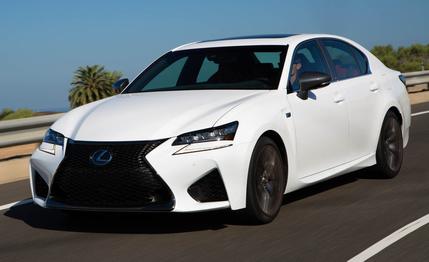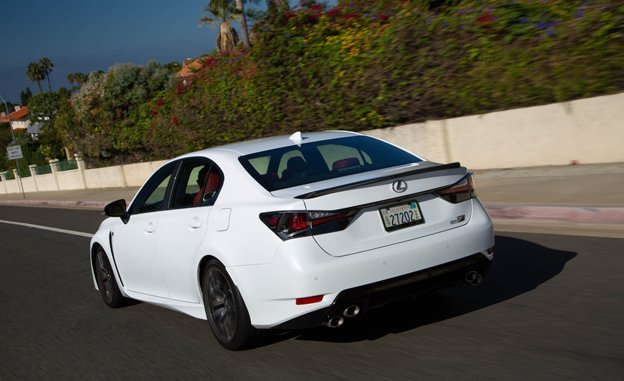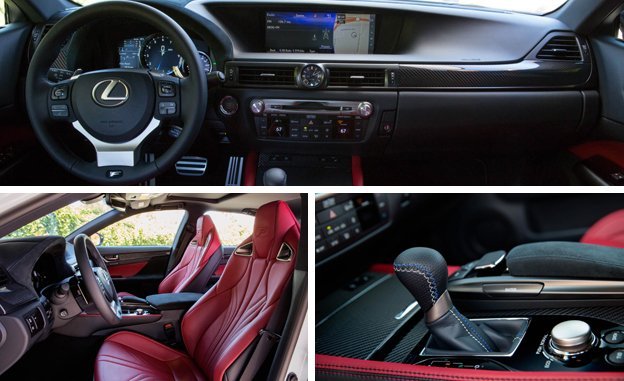
 First Drive Review
First Drive Review
F is the scarlet letter we use to mark failure or scorn. Ironically, the opposite is the case in Japan, where anything associated with that symbol commands respect. Mount Fuji is worshipped as a natural wonder. Fuji International Speedway is Japan’s version of the Nürburgring. When Toyota planned its assault on the luxury-car business in the late 1980s, Circle F was code for the Lexus LS400 flagship.
But while Lexus has offered 15 F Sport models, only three cars have merited a stand-alone F badge: the feisty IS F compact sedan introduced for 2008, the limited-edition LFA two-seat supercar for 2012, and the recent RC F coupe. Letting propagation take its course, the Lexus family will grow with a new GS F sports sedan arriving in December as a 2016 model.


In essence, the GS F is an RC F with two more doors, a real back seat, and fresh design ahead of the mainstream GS sedan’s A-pillars. This spindle-grilled special is the F for families with $85,380 to spend on an alternative to Audi’s RS7, BMW’s M5, and Cadillac’s CTS-V, as well as the Mercedes-Benz E63 AMG.
Hand-me-downs from the RC F include a 467-hp 5.0-liter V-8, an eight-speed paddle-shifted automatic, and an electronically controlled torque-vectoring differential (TVD). While competitors resort to boosted engines in their quest for power and efficiency, Lexus sticks by guns it knows best—natural aspiration for sharp throttle response, power that rises aggressively with rpm, and a feral shriek at the 7300-rpm redline.
Do not leap to the conclusion that the Lexus 32-valve V-8 is old-school. In fact, it boasts two features not found elsewhere. It squirts fuel into the intake ports and/or the combustion chambers, to ensure proper mixing of the ingredients throughout the full range of throttle positions and engine rpm. And, thanks to its versatile cam phasing (variable-valve-timing) equipment, the GS F’s engine can exploit Atkinson-cycle operation during light loads for a claimed 14-percent gain in efficiency, then run on the conventional Otto cycle when maximum power and torque are desired.
(The Atkinson-cycle backstory: In 1882, inventor James Atkinson broke the geometric bond between compression and expansion strokes by closing the intake valves after adjoining pistons had passed bottom dead center; the result was a significantly reduced charge combined with full post-combustion expansion to squeeze the maximum bang from every buck of fuel consumed.)
None of this science is evident in the GS F’s cockpit. The engine has the throttle response and vigor expected of any legitimate sports-sedan contender. And, thanks to a mode selector, you can set powertrain, stability-control-system, and climate-control parameters to suit your mood. Eco, a fashionable addition to every modern sports sedan’s lexicon, softens throttle action and diminishes energy spent on climate control. Normal is for running errands or hauling kids to school. Sport and Sport+ hone the throttle response, tailor the transmission’s shift character, and cue the enhanced engine note transmitted through the speakers. Chief engineer Yukihiko Yaguchi is quick to assert that Active Sound Control is not a synthesizer broadcasting phony motor music; rather, bad noise is electronically canceled with an out-of-phase signal and the choice notes are enhanced to produce a 7000-to-7300-rpm aria that no turbocharged engine can rival.


The engine is nestled in a unibody structure stiffened with extra adhesives, spot welds, and laser joining points. Six crossmembers add to the rigidity. Because all of the skin and structure is steel except for an aluminum front crossmember and the hood, curb weight tops 4000 pounds. That’s a lot, but not much more than the smaller RC F coupe lugs around.
In spite of all-wheel drive’s rising popularity among competitors, Yaguchi-san claims it was never considered, in large part because he had a special weapon up his sleeve. To ensure that this two-ton mama is capable of defending its honor on a racetrack, a fundamental attribute for every F model, this GS has the torque-vectoring differential painstakingly developed for the RC F [read more about it here]. A pair of planetary gearsets mounted to the output sides of an open differential add or subtract to the torque supplied to the rear wheels to help rotate the GS F about its yaw (vertical) axis. In theory, an 18-percent wheel-speed difference is possible, resulting in a rear-steer effect that’s just as forceful as what happens in front.
We enjoyed two opportunities to examine the GS F’s dynamic prowess: on mountain roads north of Madrid, Spain, and while hot-lapping the Jarama race course formerly used for Spanish Grand Prix competition. As you might imagine, this large, heavy, and predominantly gentle-riding sedan’s natural inclination is understeer. Thanks to Michelin Pilot Super Sport rubber mounted to 19-inch forged BBS wheels, there’s ample grip up to the limit. The electrically assisted steering is tuned without center slack and with quick response to yank you smartly toward apexes. Nonvariable ZF Sachs dampers stop the body roll after a few degrees of initial twitch heading into a bend.
The torque-vectoring differential serves as your bacon saver. When you conclude that all available lateral traction has been exploited and you’re bound for either the ditch or an arc wide of the apex, this device digs deep to contribute that extra bit of rotation. Seemingly defying physics, the rear axle twerks slightly sideways to nail the cornering line of your dreams.
Add to that massive, fixed-caliper Brembo brakes, a transmission with the brains to react to lateral-g loads, and bucket seats with lateral staying power, and you have a serious track weapon. Defying its slightly frumpy exterior appearance, the GS F becomes an animal when let off leash.


Configurable instrument displays and a 12.3-inch center screen controlled by a mouse plus “enter” buttons adorn the nicely outfitted interior. Trim and accent choices run the gamut with colorfully stitched leather, faux suede, carbon fiber, and matte-finish metal. A head-up display and a large sunroof are standard. The optional Mark Levinson 835-watt, 17-speaker sound system has technology that restores roughly half the digital data lost when music is compressed from CDs to satellite, streaming, and HD formats. While there’s a wealth of accident-avoidance aids, the F team has thankfully steered clear of today’s autonomous-driving movement.
We have a few gripes. The steering wheel’s rim section is needlessly fat, its perforated cover is too slippery for good grip, and little road feel is kicked back to the driver’s hands. The TVD’s bulk robs the back seat of one adult’s worth of headroom, so treats may be necessary to placate even a child assigned to the cramped middle-rear slot.
Lexus hopes to sell 2000 GS Fs in the U.S. per annum, a reasonable goal considering this brand retailed 311,000 cars last year in its pursuit of luxury leaders Mercedes-Benz and BMW. What the newest F lacks in horsepower to attack the performance gods, it makes up with a lighter curb weight and a significantly lower price. The spindle grilles may be an acquired taste, but everyone can grasp the value concept.